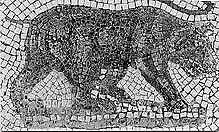Atlas bear
The names Atlas bear and African bear[1][2] (Ursus arctos crowtheri) have been applied to an extinct population or populations of the Cantabrian brown bear in North Africa. The Cantabrian brown bear likely was introduced to Africa from Spain by the Romans who imported the bears for spectacles.[3][4]
| Atlas bear | |
|---|---|
 | |
| Probable Atlas bear in Roman mosaic | |
| Scientific classification | |
| Kingdom: | Animalia |
| Phylum: | Chordata |
| Class: | Mammalia |
| Order: | Carnivora |
| Family: | Ursidae |
| Genus: | Ursus |
| Species: | |
| Subspecies: | †U. a. crowtheri |
| Trinomial name | |
| Ursus arctos crowtheri Schinz, 1844 | |
Range and description
The Atlas bear was Africa's only native bear that survived into modern times. Once inhabiting the Atlas Mountains and neighbouring areas, from Morocco to Libya, the animal is now thought to be extinct.[4] The Atlas bear was brownish-black in colour and lacked a white mark on the muzzle. The fur on the underparts was reddish-orange.[5] The fur was 4–5 inches (102–127 mm) long. The muzzle and claws were shorter than those of the American black bear, though it was stouter and thicker in body. The Atlas bear was said to have been 9 feet (2.7 m) long and weighed up to 1,000 pounds (450 kg).[6] It apparently fed on roots, acorns and nuts.[7] The Atlas bear was said to have been mostly herbivorous, but since most bears today are omnivores, the Atlas bear is believed to have been able to eat meat as well.[6] If it did eat meat, it was believed to eat small mammals as well as carrion while scavenging.[5]
Origin
Where the Atlas bear actually originated from is unknown; one genetic study was unable to link it to any brown bear, although it had weak but significant mtDNA links to the polar bear.[3] Polar bears appear in Paleolithic cave paintings in Andalucia..
Ecology
The Atlas bear's ecology is presumed to be similar to that of the other brown bears. Sympatric predators included the Barbary leopard and Barbary lion.[1][8]
Extinction
The decline of the Atlas bear can be partly attributed to the Roman Empire; as the empire expanded into North Africa, the Romans intensely hunted and captured the Atlas bear and many other animals and used them as sport for many of their games. This went on for centuries, during which time thousands of bears were used in the arenas to fight against gladiators, lions, tigers and other animals. They were cruelly treated, often starved and malnourished to increase their desperation, and hence their aggression, within the arena.[9] Thousands of these bears were also hunted for sport, venatio games, or execution of criminals ad bestias.[10] The Atlas bear became extinct shortly after modern firearms were developed. Over-hunting may have contributed to their decline. Pressure from zoo collectors sealed their fate, with the animals being taken away from one another and unable to reproduce and flourish. The Atlas bear finally became extinct in the late 19th century; the last one recorded to be killed by hunters was in 1870 in the Tetouan Mountains in northern Morocco.[11] Human activity can definitely be said to have played a large role in causing the extinction of the Atlas bear.[12] However, in the 1950s specimens of the Atlas bear have been seen in Kabylie (Algeria) by local women picking olives.[13]
References
- Bryden, H. A. (ed.) (1899). Great and small game of Africa Rowland Ward Ltd., London. Pp. 544–608.
- Schaller, p. 220–21.
- Calvignac, S.; Hughes, S.; Tougard, C.; Michaux, J.; Thevenot, M.; Philippe, M.; Hamdine, W.; Hanni, C. (2008). "Ancient DNA evidence for the loss of a highly divergent brown bear clade during historical times". Mol. Ecol. 17 (8): 1962–1970. doi:10.1111/j.1365-294x.2008.03631.x. PMID 18363668. S2CID 23361337.
- Calvignac, Sebastien; Hughes, Sandrine; Hanni, Catherine (2009). "Genetic diversity of endangered brown bear (Ursus arctos) populations at the crossroads of Europe, Asia and Africa". Diversity and Distributions. 15 (5): 742–750. doi:10.1111/j.1472-4642.2009.00586.x.
- "Atlas bear (extinct) – Bear Conservation". Retrieved 2020-10-02.
- Bob Strauss (2014), Atlas bear facts
- Mayne Reid (1865). Bruin: The Grand Bear Hunt. Ticknor and Fields.
- Nowell, Kristin; Jackson, Peter (1996). Wild Cats: Status Survey and Conservation Action Plan (PDF). Gland, Switzerland: IUCN/SSC Cat Specialist Group. pp. 1–334. ISBN 978-2-8317-0045-8.
- Ortega, Joseph J. "The Atlas Bear." PlanetEarthScience. Web. 24 October 2014. <http://planetearthscienceart.blogspot.com/2010/07/africas-only-bear-brief-natural-history.html>.
- Strauss, Bob. "Atlas Bear." About Education. 1 January 2014. Web. 22 Oct. 2014
- "Atlas bear (extinct) – Bear Conservation". Retrieved 2020-10-15.
- The Great Bear Almanac. Guilford, CT, 1993, pg. 281.
- "L'ours de l'Atlas a vraiment existé par Michel Raynal" (in French).
- Hamdinea, Watik; Thévenotb, Michel; Michaux, Jacques (1998). "Histoire récente de l'ours brun au Maghreb". Comptes Rendus de l'Académie des Sciences (in French). 321 (7): 565–570. Bibcode:1998CRASG.321..565H. doi:10.1016/S0764-4469(98)80458-7. PMID 10877599.
- Day, David (1981). The Doomsday Book of Animals: A Natural History of Vanished Species. Viking Press. pages 168-170 (includes illustration) ISBN 0-670-27987-0
- "Bears of the Last Frontier, Hour One: City of Bears: Brown Bear Fact Sheet". www.pbs.org. Web. 23 Oct. 2014.
- "The Animal Files". www.theanimalfiles.com. Web. 23 Oct. 2014.
- "Brown Bear- Ursus Arctos". The National Park Service. www.nps.gov. Web. 23 Oct. 2014.
External links
| Wikispecies has information related to Ursus arctos crowtheri. |
- "Atlas bear" at the Encyclopedia of Life

